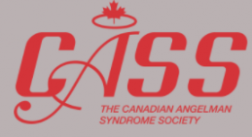Angelman Syndrome
Description of Angelman Syndrome *note: this is a student project that is still being completed[edit | edit source]
Complex genetic disorder affecting the nervous system. It is characterized by severe learning difficulties, motor dysfunction, seizure disorder, and often a happy, sociable disposition.
Prevalence[edit | edit source]
Affects approximately 1 in 15,000 individuals (Margolis et al)
Epidemiology[edit | edit source]
- Onset is usually before the age of 3 (Margolis)
- Caused by 4 molecular mechanisms (Kishino)
- Maternal deletions of chromosome 15q11-q13 (70-80%)
- Intragenic mutation in maternally inherited UBE3A which is found in chromosome 15q11-q13 (10-20%)
- Paternal uniparental disomy (UPD) in chromosome 15q11-q13 (3-5%)
- Imprinting defects in chromosome 15q11-q13 which change the expression of UBE3A (3-5%)
- Those with deletion have more severe disease and those with UPD and imprinting have less severe defects (Margolis)
Clinical Presentation[edit | edit source]
- Observable Presentation
- Facial features - thin upper lip, wide spaced teeth
- Scoliosis (20% of children/50% adults) (reference from guidelines)
- Motor Presentation
- Motor dysfunction - tremors, jerkiness, ataxia
- Behavioural Presentation
- Developmental delay is normally seen within the first year of life
- most patients lack speech completely but those mildly affected can speak a few words
- Severe intellectual disability
- Hyperactivity and short attention span
- Mouthing of objects
- Happy demeanor with increased laughter, and often an attraction to water
- Developmental delay is normally seen within the first year of life
- Additional Comorbidities that present
- Seizures (60% of individuals)
- Autism spectrum disorder (ASD),
- Digestive system complications
- constipation
- gastroesophageal reflux
Diagnostic Procedures[edit | edit source]
Patients with Angelman Syndrome are often diagnosed within their first year of life. Diagnosis should be confirmed with genetic testing to determine DNA methylation (Margolis et al.)
Differential Diagnosis
[edit | edit source]
add text here relating to management approaches to the condition
Outcome Measures
[edit | edit source]
add text here relating to the differential diagnosis of this condition
Physiotherapy Management and Treatment
[edit | edit source]
text here
Additional Treatment
[edit | edit source]
Clinical Guidelines for Angelman Syndrome[edit | edit source]
For more detailed information on the treatment of Angelman Syndrome across several health care providers, clinical guidelines have been created by the Angelman Syndrome Guideline Development Group. Visit their document here [1].
Additional Resources[edit | edit source]
Canadian Angelman Syndrome Society:
- Visit their webpage here [2]
FAST: Foundation of Angelman Syndrome Therapeutics
- Visit their webpage here [3]
References[edit | edit source]
Margolis, Seth S., Gabrielle L. Sell, Mark A. Zbinden, and Lynne M. Bird. "Angelman syndrome." Neurotherapeutics 12, no. 3 (2015): 641-650.
Kishino, Tatsuya, Marc Lalande, and Joseph Wagstaff. "UBE3A/E6-AP mutations cause Angelman syndrome." Nature genetics 15, no. 1 (1997): 70.







